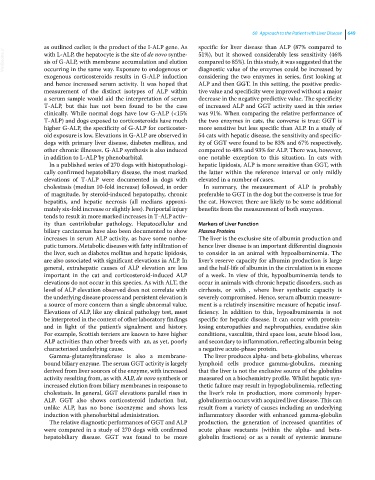Page 681 - Clinical Small Animal Internal Medicine
P. 681
60 Approach to the Patient with Liver Disease 649
as outlined earlier, is the product of the I‐ALP gene. As specific for liver disease than ALP (87% compared to
VetBooks.ir with L‐ALP, the hepatocyte is the site of de novo synthe- 51%), but it showed considerably less sensitivity (46%
compared to 85%). In this study, it was suggested that the
sis of G‐ALP, with membrane accumulation and elution
occurring in the same way. Exposure to endogenous or
considering the two enzymes in series, first looking at
exogenous corticosteroids results in G‐ALP induction diagnostic value of the enzymes could be increased by
and hence increased serum activity. It was hoped that ALP and then GGT. In this setting, the positive predic-
measurement of the distinct isotypes of ALP within tive value and specificity were improved without a major
a serum sample would aid the interpretation of serum decrease in the negative predictive value. The specificity
T‐ALP, but this has not been found to be the case of increased ALP and GGT activity used in this series
clinically. While normal dogs have low G‐ALP (<15% was 91%. When comparing the relative performance of
T‐ALP) and dogs exposed to corticosteroids have much the two enzymes in cats, the converse is true: GGT is
higher G‐ALP, the specificity of G‐ALP for corticoster- more sensitive but less specific than ALP. In a study of
oid exposure is low. Elevations in G‐ALP are observed in 54 cats with hepatic disease, the sensitivity and specific-
dogs with primary liver disease, diabetes mellitus, and ity of GGT were found to be 83% and 67% respectively,
other chronic illnesses. G‐ALP synthesis is also induced compared to 48% and 93% for ALP. There was, however,
in addition to L‐ALP by phenobarbital. one notable exception to this situation. In cats with
In a published series of 270 dogs with histopathologi- hepatic lipidosis, ALP is more sensitive than GGT, with
cally confirmed hepatobiliary disease, the most marked the latter within the reference interval or only mildly
elevations of T‐ALP were documented in dogs with elevated in a number of cases.
cholestasis (median 10‐fold increase) followed, in order In summary, the measurement of ALP is probably
of magnitude, by steroid‐induced hepatopathy, chronic preferable to GGT in the dog but the converse is true for
hepatitis, and hepatic necrosis (all medians approxi- the cat. However, there are likely to be some additional
mately six‐fold increase or slightly less). Periportal injury benefits from the measurement of both enzymes.
tends to result in more marked increases in T‐ALP activ-
ity than centrilobular pathology. Hepatocellular and Markers of Liver Function
biliary carcinomas have also been documented to show Plasma Proteins
increases in serum ALP activity, as have some nonhe- The liver is the exclusive site of albumin production and
patic tumors. Metabolic diseases with fatty infiltration of hence liver disease is an important differential diagnosis
the liver, such as diabetes mellitus and hepatic lipidosis, to consider in an animal with hypoalbuminemia. The
are also associated with significant elevations in ALP. In liver’s reserve capacity for albumin production is large
general, extrahepatic causes of ALP elevation are less and the half‐life of albumin in the circulation is in excess
important in the cat and corticosteroid‐induced ALP of a week. In view of this, hypoalbuminemia tends to
elevations do not occur in this species. As with ALT, the occur in animals with chronic hepatic disorders, such as
level of ALP elevation observed does not correlate with cirrhosis, or with , where liver synthetic capacity is
the underlying disease process and persistent elevation is severely compromised. Hence, serum albumin measure-
a source of more concern than a single abnormal value. ment is a relatively insensitive measure of hepatic insuf-
Elevations of ALP, like any clinical pathology test, must ficiency. In addition to this, hypoalbuminemia is not
be interpreted in the context of other laboratory findings specific for hepatic disease. It can occur with protein‐
and in light of the patient’s signalment and history. losing enteropathies and nephropathies, exudative skin
For example, Scottish terriers are known to have higher conditions, vasculitis, third space loss, acute blood loss,
ALP activities than other breeds with an, as yet, poorly and secondary to inflammation, reflecting albumin being
characterised underlying cause. a negative acute‐phase protein.
Gamma‐glutamyltransferase is also a membrane‐ The liver produces alpha‐ and beta‐globulins, whereas
bound biliary enzyme. The serum GGT activity is largely lymphoid cells produce gamma‐globulins, meaning
derived from liver sources of the enzyme, with increased that the liver is not the exclusive source of the globulins
activity resulting from, as with ALP, de novo synthesis or measured on a biochemistry profile. Whilst hepatic syn-
increased elution from biliary membranes in response to thetic failure may result in hypoglobulinemia, reflecting
cholestasis. In general, GGT elevations parallel rises in the liver’s role in production, more commonly hyper-
ALP. GGT also shows corticosteroid induction but, globulinemia occurs with acquired liver disease. This can
unlike ALP, has no bone isoenzyme and shows less result from a variety of causes including an underlying
induction with phenobarbital administration. inflammatory disorder with enhanced gamma‐globulin
The relative diagnostic performances of GGT and ALP production, the generation of increased quantities of
were compared in a study of 270 dogs with confirmed acute phase reactants (within the alpha‐ and beta‐
hepatobiliary disease. GGT was found to be more globulin fractions) or as a result of systemic immune

